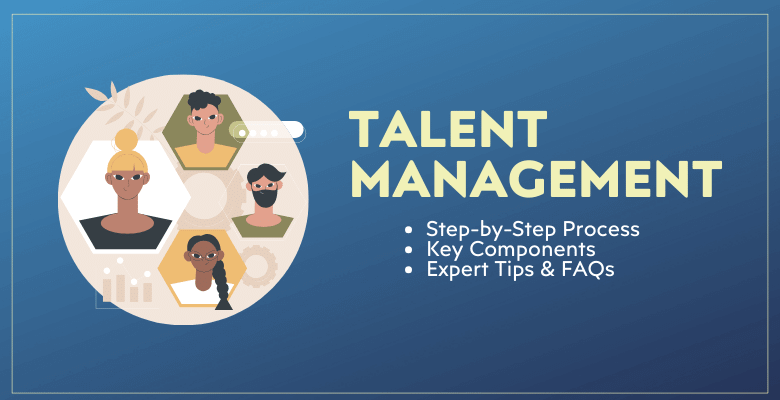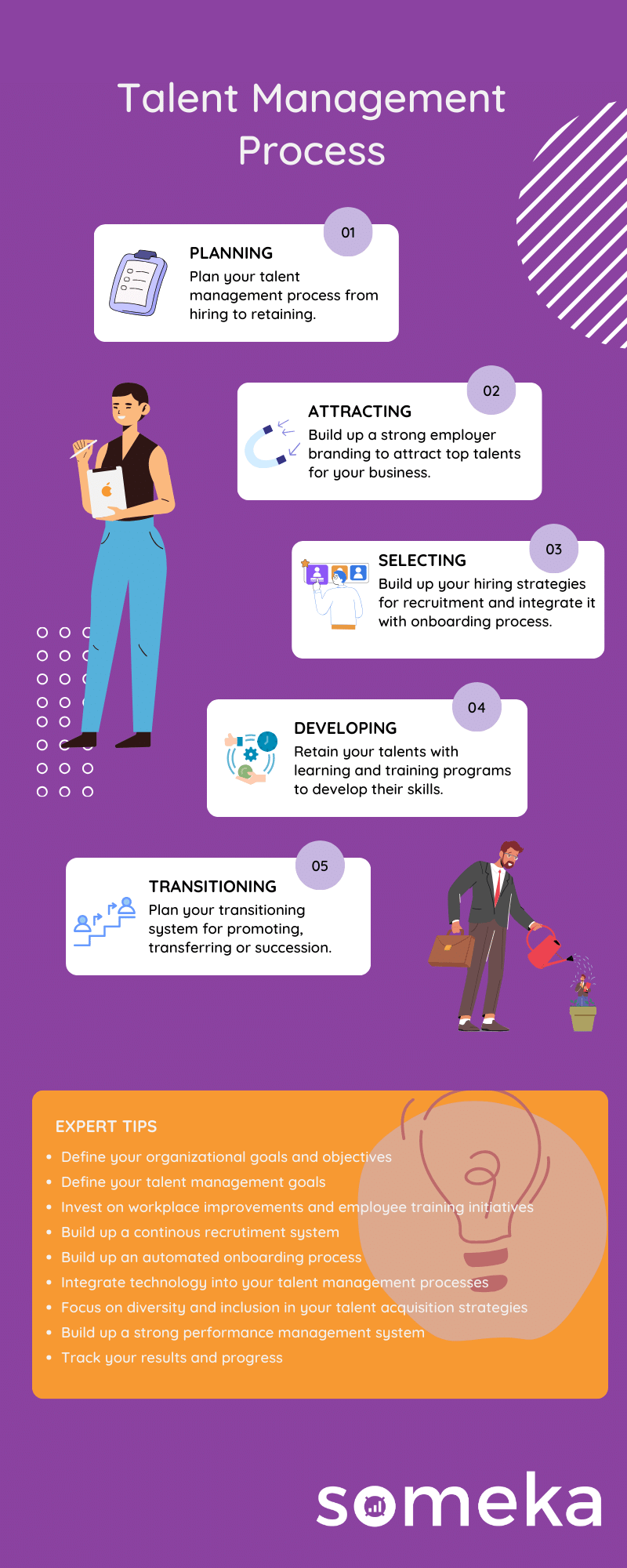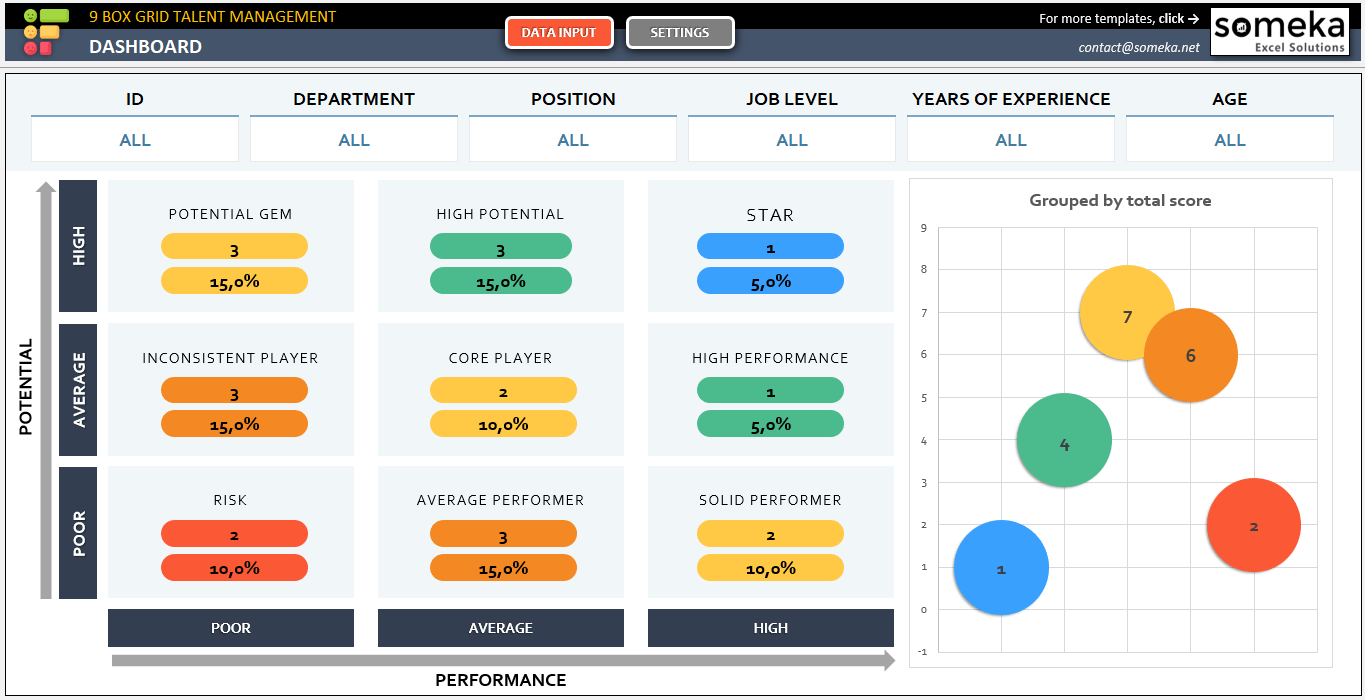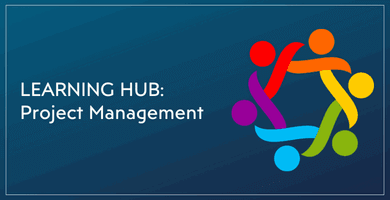
What’s Talent Management? Definition, Strategy, Process
How will you find star employees? How to you retain your existing staff? What’s your plan for their career development? In summary, how should you manage your talent pool? Here’s a complete guide about talent management covering all aspects from talent acquisition to retainment strategies.
Table Of Content
1. What’s Talent Management?
2. Key Components of a Successful Talent Management Strategy
3. Talent Management Process
4. Key Principles of Talent Management
5. Utilizing Technology in Talent Management
6. Addressing Diversity and Inclusion
7. Tips for a Successful Talent Management
8. FAQ’s on Talent Management
Key Takeaways
- Talent management is a comprehensive strategy for optimizing employee engagement and meeting long-term organizational goals.
- Human Resources (HR) plays an important role in talent management. Because, HR ensures the acquisition, development, and retention of highly skilled employees.
- A successful talent management strategy requires aligning with objectives, fostering a positive environment and investing in training programs.
1. What’s Talent Management?
Talent management is a strategic process used to identify, develop and retain the most capable employees in order for organizations to reach their long-term objectives while also enhancing employee engagement. By using this strategy appropriately, businesses can increase workforce productivity along with its overall competitiveness.
There are multiple steps which form part of an effective talent management approach. This may include discovering discrepancies among the current staff members, recruiting new personnel strategically after due assessment coupled with utilizing applicant tracking tools if necessary.

Onboarding said hires followed by training/mentorship plans should be enacted too. All these actions enables performance optimization. When combined with adequate feedback from supervisors relying on real time data metrics regarding team proficiency levels, an effective talent management will ensure a pleasant work environment with motivating personnel. Thus fostering superior interaction between employer and worker alike.
By way of example, one firm had success implementing recruitment software solutions alongside modern monitoring methods resulting in enhanced quality control allowing it maximize performance outcomes even more so via enlightened talent administration practices.
The Role of Human Resources in Talent Management
Human Resources (HR) occupies a fundamental part in the talent management model. It handles activities such as performance management, succession planning, recruiting and retaining employees, and training them to improve their abilities and knowledge through learning development initiatives for career advancement opportunities.
HR has devised various strategies targeted at maintaining employee retention within its Talent Management Model, like ensuring timely communication between all personnel levels. Executing job satisfaction reviews plus delivering incentivized rewards programs with long-term goals related to maintaining an intrinsic connection between work efforts & organisational outcomes thus decreasing the turnover rate intentions of valuable people assets.
2. Key Components of a Successful Talent Management Strategy
A successful talent management plan involves multiple key components, such as making sure it is in sync with organizational objectives, fostering a positive employee experience and designing/implementing training programs. Ensuring the talents of staff members contributes to achieving goals set by your business helps drive its success.
Not only does a great employee experience bring top-notch people into an organization, but it also enables existing workers to stay there too. Also critical for effectiveness are specialized courses that enable employees to advance their skills thereby helping the company move forward overall. The following sections will explain each factor’s role within an effective talent management strategy.
This approach will open the door for more innovation and growth by utilizing a workforce to its full potential resulting in better overall performance. To successfully create and apply such a strategy, one must take into account the different components, processes, and principles of talent management. This will include technology utilization and diversity & inclusion topics. Together these elements can help guarantee long-term business victory when executed correctly with key components like an effective talent management system at its foundation.

Aligning with Organizational Objectives
Making a plan is the first step in managing talent. To do this, you need to write job descriptions, figure out what the gaps are between current resources and desired results, and come up with a plan to hire the right people. An important part of managing workers is getting them ready for their jobs. This helps match human capital goals with business goals so that the company can succeed in the future.
Companies can plan ahead and hire the right people when they need to if they know where the skills gaps are. In this case, the company sets goals that have been agreed upon by leaders at every level, and the employees are helped to reach those goals. Plan ahead for the types of people you will need, and you can see what skills and abilities you will need in the future. This way, they know they’ll always have skilled workers on hand.
 10. What Are 9 Box Alternatives?
10. What Are 9 Box Alternatives?
Creating a Positive Employee Experience
Fostering a good experience for employees is essential to attracting and keeping top talent. Person-organization fit centers on how closely an individual’s beliefs match up with the corporate culture. When people feel that there is a congruence between these two elements, they are more likely to be productive, committed and engaged in their job.
To encourage positive employee experiences, many firms have put into place strategies such as Google’s “20% Time” initiative, Amazon’s leadership principles or Oxford University Hospitals’ “Leadership and Development” framework, all geared towards cultivating development opportunities which contribute not only to increased business success but also advances employee performance. Companies like Spreetail focus highly on creating a better candidate experience while Omnidian offers its ‘Sol Mate’ program aiming at helping create an enjoyable work environment leading ultimately beneficial results for everyone involved.

Developing and Implementing Training Programs
Career development is an essential part of talent management. It allows individuals to acquire fresh skills and advance their career, which leads to increased motivation, productivity, as well as loyalty towards the organization. To ensure this process goes successfully, it should be composed of factors such as technological abilities improvement, soft skills education, advancement in one’s current role or position, networking occasions, educational attainment & personal growth.
In addition, investing in training programs presents a great advantage for both employees and companies alike: sharpening team members’ capacities making them more effective workers; staffing with high-performing personnel who prefer continual progress and augmentation of each employee knowledge inventory enhancing versatility within the firm improved business performance efficiency and effectiveness Speaking. All in all, investing in employee’s growth produces positive outcomes that are beneficial for every party involved.
3. Talent Management Process
The talent management process is essential for ensuring that the organization has access to the right individuals with suitable skills and development opportunities.
Its components consist of planning, attraction, selection, developing employees’ abilities as well as maintaining them in their positions by providing necessary support while transitioning staff if needed.

To guarantee effectiveness of such processes, certain best practices should be applied. These include careful consideration when formulating plans, designing methods to bring on board ideal candidates, selecting these based on specific requirements and work conditions, continuously offering training or learning activities. So, they are able to keep up with current trends without abandoning their roots within company culture, retaining personnel through attractive benefits packages and motivating factors like recognition awards or promotions, ultimately leaving an open door policy upon departure .
All this can lead to successful performance outcomes which serve a greater purpose than individual benefit alone – working towards organizational goals together collaboratively under one roof creates strong cohesive teams ready to take business operations into new directions swiftly whenever required!
Planning
The first step in talent management is planning. This includes figuring out what the gaps are between present resources and desired outcomes, writing job descriptions, and making a strategy to find the right people to hire. Preparing the workforce is an important part of managing workers because it helps align human capital goals with business goals so that the company can succeed in the future. When companies know where the gaps are between the supply and demand of skills, they can plan ahead and take action when they need to hire people.

In this case, goals are set for the company that have been approved by leaders at all levels of the hierarchy, and staff are given help to meet those goals. Companies can figure out what skills and abilities they will need in the future by planning what kind of workers they will need. This way, they can be sure they will always have skilled workers available.
Attracting
A strong employer brand is important for getting the best workers, setting your company apart from others in the same field, and showing off all the unique benefits it offers.
In addition to having a great image, hiring strategies need to be well thought out in order to attract good candidates. This means using a lot of different sources, like job boards, social media, employee recommendations, and staffing firms. As well as writing detailed job descriptions that spell out the skills and responsibilities needed for each post.
When you’re trying to hire the best people, you need a strong employer brand and targeted staffing plans. Make sure that accurate descriptions of skills and tasks are clearly displayed to make sure you hire the right people.
Selecting
Choosing the right people for your business is very important for its success because it lets you choose from people who have the skills and experience you need. This increases output, improves performance, encourages teamwork, and creates an atmosphere that makes employees less likely to leave.
Several methods can be used to find out how well people fit in with the company culture and how well they can do their job. These include reviewing resumes, conducting interviews, giving online tests, or evaluating work samples or case studies.

It’s also important for applicants to have good experiences during the hiring process. This not only increases the chances of getting top talent, but it can also help the company’s image, which makes it an appealing place to work.
Developing
Investing in staff development is important if you want your group to keep doing well. This can be done by figuring out who on the team has the best skills and qualifications, setting up ways for everyone to keep learning, and setting goals and ways to measure success. Focusing on building a good company brand and improving the work experience of employees.
By giving your employees chances to learn, get noticed, and get better, you can create an environment that values their participation, which will eventually lead to a higher retention rate.
Retaining
It is important for businesses to have good talent management if they want to keep their best employees. The best way to do this is to make sure that everyone feels welcome at work, you can set up a robust performance management software and create clear job paths.
You should also offer competitive benefits and feedback or coaching.
By focusing on keeping employees, you may be able to cut down on the costs of turnover while also making employees stronger by giving them more knowledge and better skills. Such steps are very important for businesses that want to be successful in the long run because they help them keep the high-performing employees who are working hard to help the business grow.
Transitioning
It is essential to have a smooth transition plan in place when it comes to promoting, transferring or succession planning employees. This strategy helps maintain organizational performance by ensuring that key positions are filled with personnel who can take on new roles and responsibilities effectively. By having this process mapped out beforehand, you minimize any disruption which may occur due to change within your organization.

4. Key Principles of Talent Management
Building a strong talent management strategy requires that certain key principles be followed. These include aligning with organizational objectives, fostering an uplifting work atmosphere and investing in employee growth. Doing this allows for the development of a firm foundation to bring forth diverse teams needed to compete within today’s competitive markets. These efforts are essential for creating positive results from your talent pool in order to reach success organizationally speaking as well as globally.
Talent Management Strategy
A successful talent management strategy encompasses all aspects of the employee lifecycle to reach long-term business success. This includes attracting and recruiting top talents, fostering their professional growth through development, creating a positive employer brand for retention purposes, cultivating internal potentials via promotion opportunities and employing only highly skilled personnel. Through these comprehensive strategies, your organization can boost its productive capacity while ensuring that it reaches optimal performance levels in the future.
Building a Strong Employer Brand
Enhancing your company’s employer brand can be a key step in both drawing top talent to your organization and keeping existing employees. Your unique culture, values, and benefits should serve as the foundation for building this robust image that speaks well of you within the industry.

To successfully create an effective employer brand, some strategies could include:
- Refining internal operations
- Offering attractive incentives or rewards
- Shaping recruitment efforts with sincerity & honesty
- Receiving feedback from candidates
- Recognizing standout staff members across academic sectors
Investing in the right type of branding will help set you apart from competitors while creating a positive professional reputation which is sure to attract and retain premier personnel, potentially boosting organizational performance too! It’ll ensure long-term success when establishing any sort of Talent Management Strategy going forward.
Nurturing Internal Talent
Successful talent management requires the cultivation of internal employees in order to maintain a steady supply of skilled individuals who are eager and able to seize upon new opportunities. To promote learning, growth, productivity and performance as a whole, high-potential workers must be identified so that they can have access to resources necessary for success along with chances for development.

Hiring Promising Specialists
Recruiting talented specialists with the right combination of skills, knowledge and attitude is paramount in today’s competitive business environment. Focusing on sourcing promising professionals ensures your company has what it takes to succeed and keep ahead of competition.
To this end, an effective recruitment process involving thorough assessment steps can be essential for hiring candidates who will contribute to future success, e.g., resume reviews, phone or video interviews, online tests, work samples, etc. By being meticulous when selecting applicants, you are able to better identify those individuals that possess the requisite qualifications necessary for maintaining a productive workplace and achieving organizational objectives over time.
Hiring Only Top Employees
By having a talent management strategy that focuses on acquiring only the highest qualified staff, businesses can make certain of an exceptional-performing workforce and gain lasting competitive advantages. This approach not only stimulates productivity and innovation, but also fosters engaged workers in a positive atmosphere which leads to higher employee retention rates. Ultimately, this provides long-term business triumphs through investing in topnotch employees who are capable of delivering superior results.
5. Utilizing Technology in Talent Management
In the modern digital age, technology has a significant influence on talent management. Talent management systems streamline processes and enable data-driven decision making to produce better results for businesses. Through utilization of tech tools, companies can automate duties as well as acquire knowledge that will help facilitate efficient and successful oversight in various areas associated with staffing operations – ultimately leading to advantageous business outcomes.
In the realm of talent management, cybersecurity is crucial to protect sensitive employee and organizational data. Implementing robust cybersecurity measures, including the use of enterprise password managers, two-factor authentication, and regular security audits, ensures that employee information is safeguarded against potential threats. Password managers can help securely store and manage credentials, reducing the risk of breaches. Regular training on cybersecurity best practices for employees further strengthens the organization’s defense against cyber threats. This proactive approach not only protects data but also fosters trust and confidence among employees.
We’ll take an even closer look at how this is done through talent system implementation combined with analytically informed conclusions below.

Talent Management Systems
Talent Management Systems (TMS) are software solutions designed to make the management of talent processes easier. They can assist with job postings, screening applicants, scheduling interviews and tracking applicant progress. This automation reduces administrative tasks associated with hiring so that organizations have more time to focus on their core business goals.
When selecting a TMS it is important to evaluate features such as:
- Applicant Tracking & Recruiting
- Compensation Management
- Learning Management
- Mobile Capabilities
- Performance Evaluation Tools
- Social Media Integration capabilities
- Compliance safeguards for data security
- Accessibility/usability
Having these considerations in mind will ensure an organization chooses a system tailored specifically to its needs which helps them acquire top-tier talent efficiently while still adhering to all guidelines for safety/privacy standards. Lastly, analytics dashboards within the systems allow companies to track success rates in order to manage people performance accordingly ensuring you get the most out of your workforce overall.
Data-Driven Decision Making
Organizations can use data-driven decision-making to make better choices regarding their talent management. Collected and analyzed information provides key insights into recruitment approaches, performance reviews, learning & development opportunities, as well as succession planning initiatives. These findings enable businesses to be more objective in decision making. Identify employees with high potentials and consequently optimize strategies while maintaining alignment of objectives between the talent organization goals and corporate intentions.
You can use common performance evaluation models in your decision making systems. Someka provides lots of performance evaluation templates for you. Below are some of the examples from our portfolio:
a. 9 Box Grid Talent Management Templates
9 Box grids are evaluation tools to categorize employees according to their performance and potential levels.
Below is an example of a how a Nine-Box format can be used for talent pool evaluations:
– This is the Dashboard of 9 Box Excel Template created by Someka. –
You can also download a Google Sheets 9 Box template if you perfer online tools for your internal documentations.
b) Performance Review Templates
You can integrate performance review forms to your talent management systems to make continuous evaluations. The Performance Review Excel Template created by Someka is one of the best tools to create review forms.
c) Peer Reviews
You can also use peer review forms to gather feedback for each employee for their colleagues. This might be completed in a smooth way to keep up the work peace.
d) Employee Evaluation Tools
Another example might be comprehensive employee evaluation tools:
– This image is from Someka’s Employee Evaluation Excel Template –
6. Addressing Diversity and Inclusion
A successful talent management strategy must prioritize diversity and inclusion in order to reap the many rewards a diverse workforce brings. By creating an environment that is both welcoming and inclusive of all backgrounds, organizations can effectively attract and retain top-tier talent while benefiting from unique perspectives within their employee base.
The below sections will Examine how fostering diversification helps businesses succeed as well as strategies for ensuring maximum inclusivity within the workplace.

Benefits of a Diverse Workforce
Promoting diversity and creating a welcoming environment can help companies get the most out of their workers, which can lead to more innovation, better decisions, and greater success. As much as 87% of studies have shown that groups with more diversity are better at making decisions than teams with only one type of person.
Accepting a diverse staff means accepting a range of ideas, skills, and experiences. All of these things help businesses do better generally.
Strategies for Promoting Inclusivity
Organizations can become more inclusive by offering diversity training, making rules that are open to everyone, and creating a positive work environment. These steps can help employees learn more about the different kinds of diversity and how unconscious bias might affect how they work with others. Making a workplace where everyone feels respected, no matter who they are or what they believe, will help bring more diversity into the workforce.
7. Tips for a Successful Talent Management
For the development of a successful talent management strategy, there are several essential tips to consider.

We’ll summarize the main tips for you:
- Define your organizational goals and objectives
- Define your talent management goals
- Invest on workplace improvements and employee training initiatives
- Build up a continuous recruitment system
- Build up an automated onboarding process
- Integrate technology into your talent management processes
- Focus on diversity and inclusion in your talent acquisition strategies
- Build up a strong performance management system
- Track your results and progress
These main areas provide guidance on how best construct a powerful talent management system.
8. FAQ’s on Talent Management
Talent management is a key factor to consider for organizations. It involves developing and retaining high-performing employees while also recruiting new ones. To ensure that the talent management strategy aligns with overall business objectives, there must be an action plan in place.
What are the 4 types of talent management?
Managing talent encompasses four main elements: recruiting and onboarding, performance management, career development, as well as rewards and recognition. All of these combined are essential for effectively managing any given team’s talents to help reach organizational goals.
What are the 7 components of talent management?
Talent management includes: Recruitment, Onboarding, Orientation, Recognition, Compensations and Benefits, Learning & Development activities, Performance Tracking.
What is the difference between HR and talent management?
Talent Management, a subdivision of Human Resource Management, concentrates on preserving and cultivating the top talent in the organization. As opposed to HR that is mainly related to managing salaries, holidays, perks and conflicts resolution, Talent Management emphasizes methods for developing employees by creating career paths along with providing relevant training programs.
What does a talent management do?
Talent management is a systematic process which aims to identify, evaluate, and develop the talent within an organization. It also involves providing learning opportunities for employees, engaging with them throughout their careers in order to foster growth and motivation while continuing to attract new top-level candidates. By focusing on recruitment as well as developing current staff members. This approach ensures that businesses have access to skilled personnel who are continuously motivated and inspired by workplace challenges.
How can I improve employee retention in my organization?
To help with employee retention, your organization can offer competitive compensation and benefits packages, provide continuous feedback and mentoring to develop career paths, and implement a performance management system for improvement opportunities. Plus, foster an atmosphere of inclusion.
Recommended Readings:





